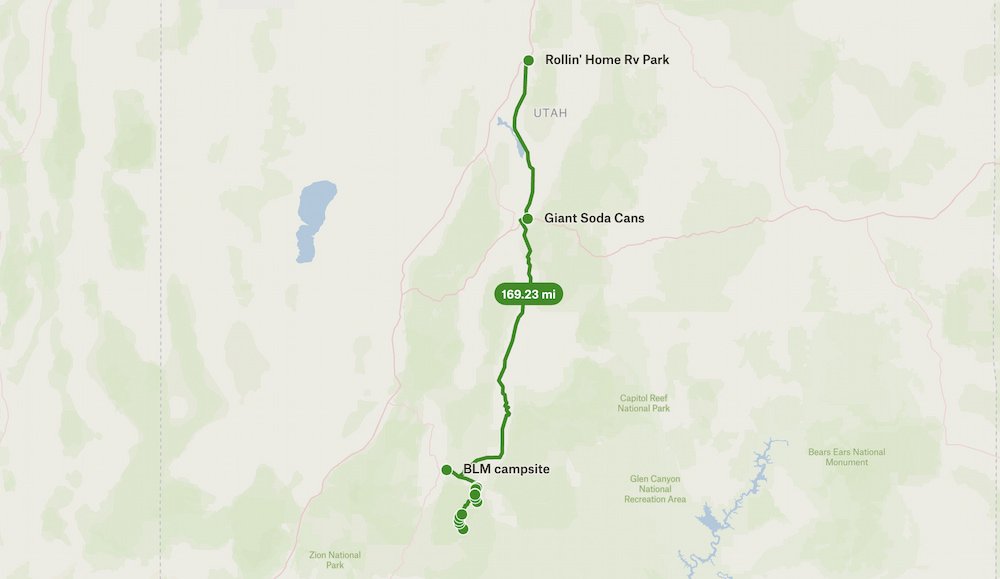Could Bryce Canyon National Park be the best national park we've been to? While we've been to a lot of national parks, national monuments, and state parks on this trip already, right now, the answer is YES, Bryce tops the list. Read on to find out why...
(As an aside, there are 63 national parks in the US! Even though we're doing an epic road trip that doesn't include Alaska, we won't be able to hit up all the national parks, but will be seeing quite a lot! Secondly, do you know the difference between a National Park versus National Monument designation, and a National Park versus State Park? Answers at the end of this post).
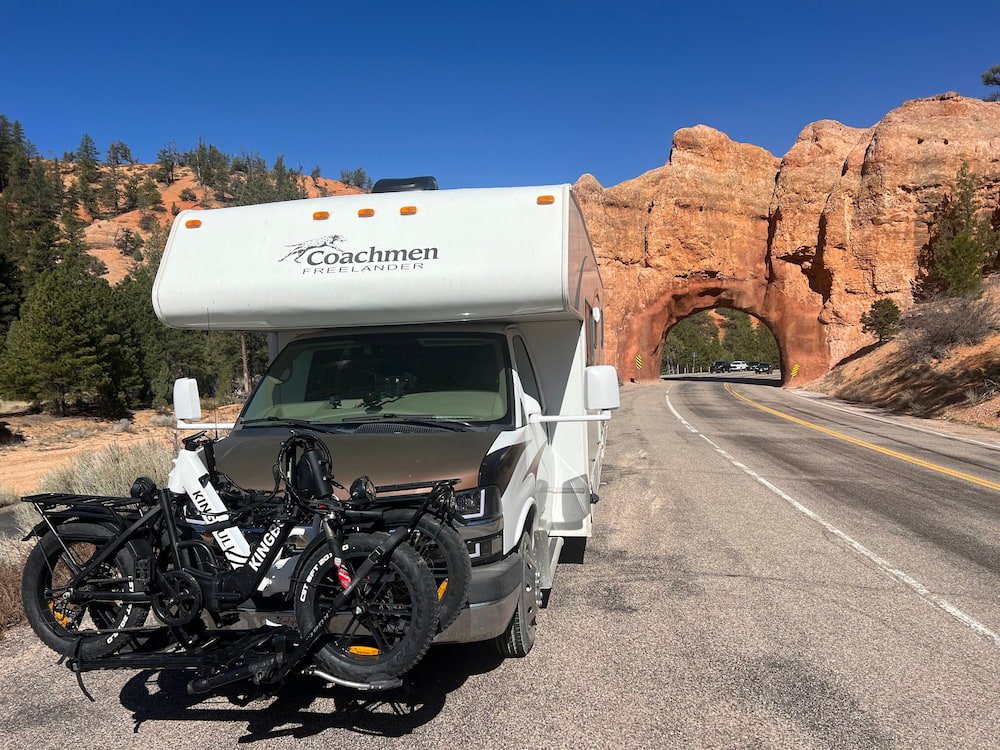
Hoodoo Gurus
Bryce Canyon's claim to fame is that it has the highest concentration of hoodoos in the world. A hoodoo (also called a fairy chimney or tent rock) is a tall, thin and irregular rock column, with relatively soft rock topped by harder, less eroded stone. Hoodoos are all shapes and sizes, with some as tall as a 10-story building. Because of their unique shapes, Bryce Canyon's original inhabitants, the Paiutes, believed that hoodoos were people turned to stone by angry gods.
While it had been sunny and hot visiting Zion National Park the day before, Bryce Canyon National Park, a mere 1 hour 20 minutes drive away, was positively icy! We experienced a massive drop in temperature overnight, which reignited Michael's head cold. We took our time to drive to Bryce Canyon, arriving there midmorning, but saw a sign before we reached the entrance that the parking lot was already full. Equipped with our experience from Zion, we parked our RV on the outskirts of the park, and took a shuttle into Bryce Canyon, heading first to the Visitor Center.
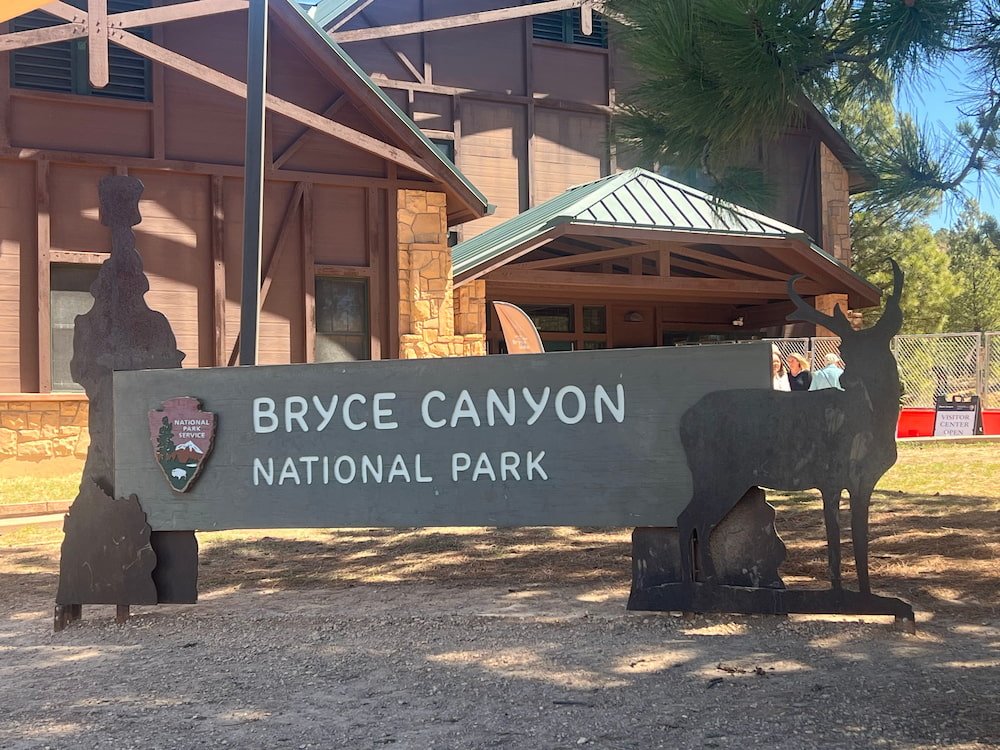
The Visitor Center was packed with people -- besides the gift shop, there's an interesting exhibit detailing the formation of the hoodoos, and the history and cultural significance of the Park. We also watched a short film in the theater, which shows the beauty of the park in all four seasons.
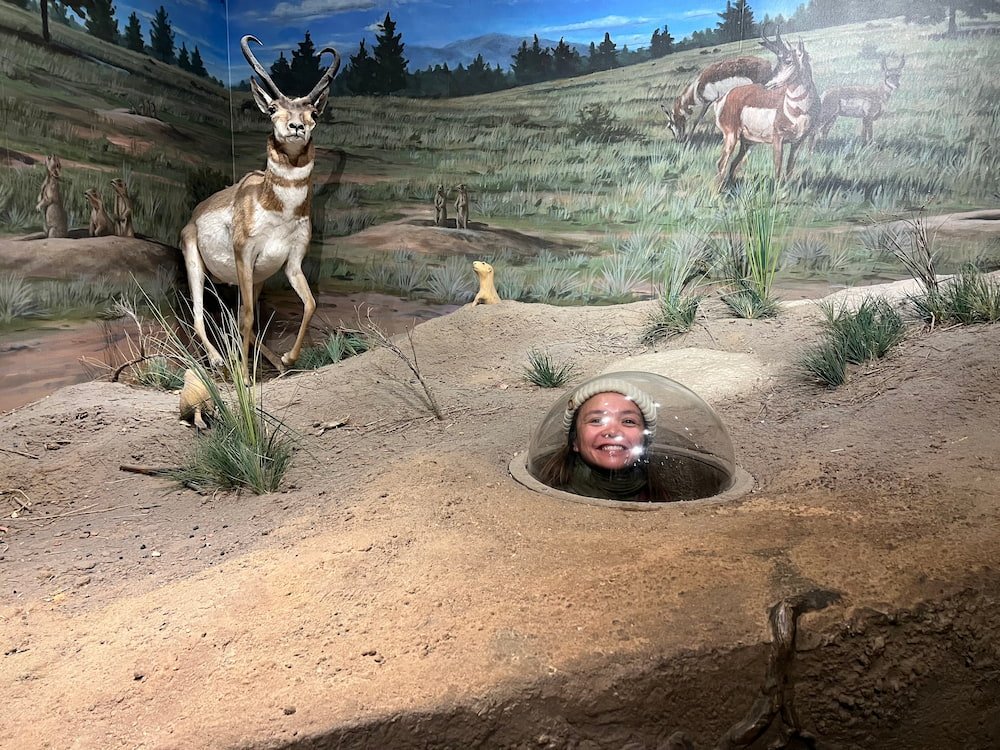
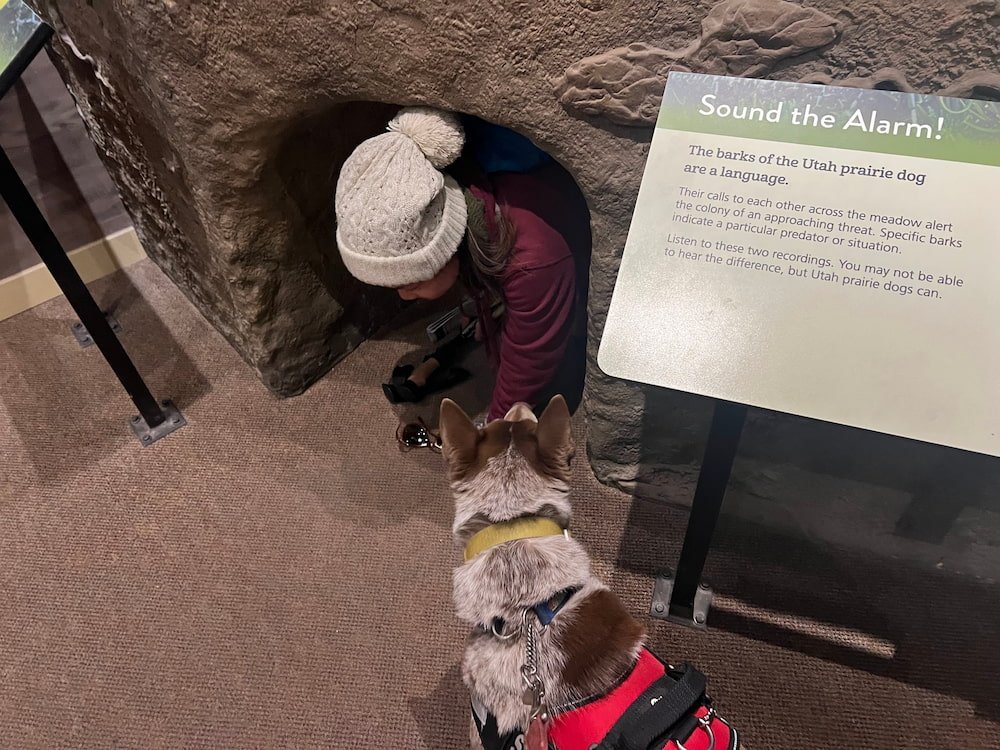
Rather than tackle a decent hike today, we decided to orient ourselves to Bryce Canyon, returning by shuttle to our RV and driving to the last stop, Rainbow Point, where there's a 1.6 kilometer (1 mile) trail called Bristlecone Loop that ascends up to 61 meters (200 feet) to see bristlecone pines and expansive vistas. While it sounds short and easy, since it's quite an elevated hike, it's possible to feel winded much more quickly, as Michael discovered as we were walking up toward the highest point of the trail! Additionally, in 2018 lightning strikes caused two separate fires that merged, so there are still blackened tree stumps and areas that continue to be burned as part of ongoing efforts to reduce the chances of such infernos from reoccurring.
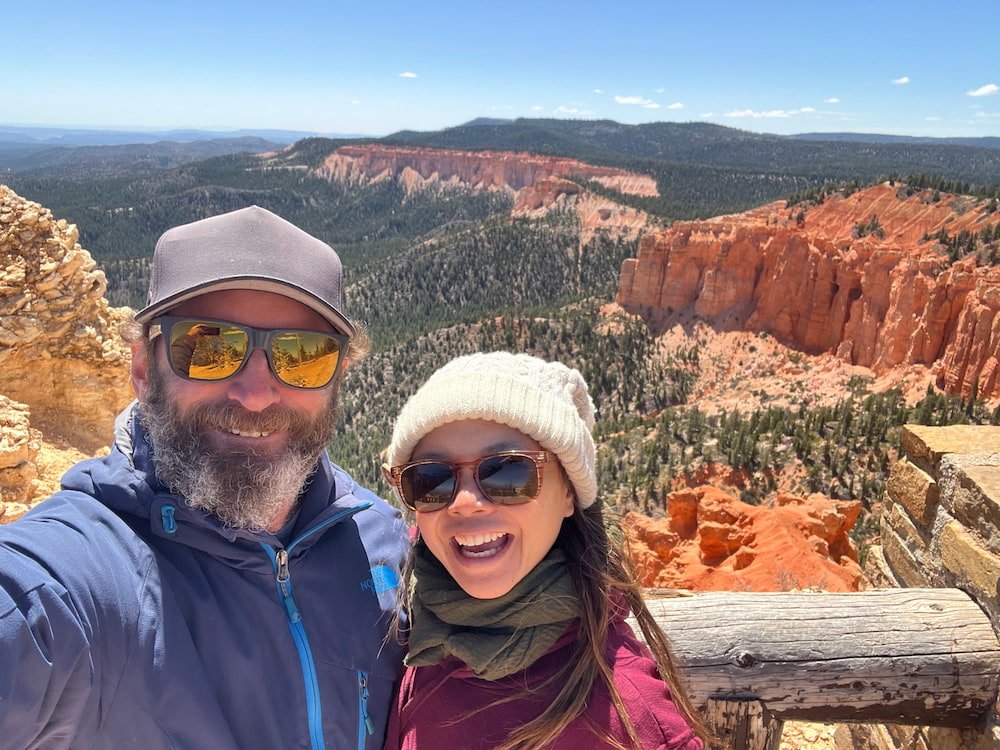
About an hour later, we made our way back to the RV (which was crammed with vehicles parking in all sorts of spots, making it slightly difficult for us to exit), and made a point to stop at every vista point as we made our way out of the national park. Every vista was awesome, as each was so different, showcasing impressive hoodoos, beautiful snowy mountains in the background, and even patches of snow on the ground near us. The snowy whites, rich reds and grassy greens all popped out, yet merged together to make for a gorgeous landscape. One of the viewpoints, called Natural Bridge, is obviously called this thanks to its massive 25 meter (85 foot) arch, carved out of sedimentary red rock, spanning over millions of years. It was the only significant arch that we saw that day, which was reminiscent of our memorable visit to Arches National Park, where we got our fill of arches over three days.
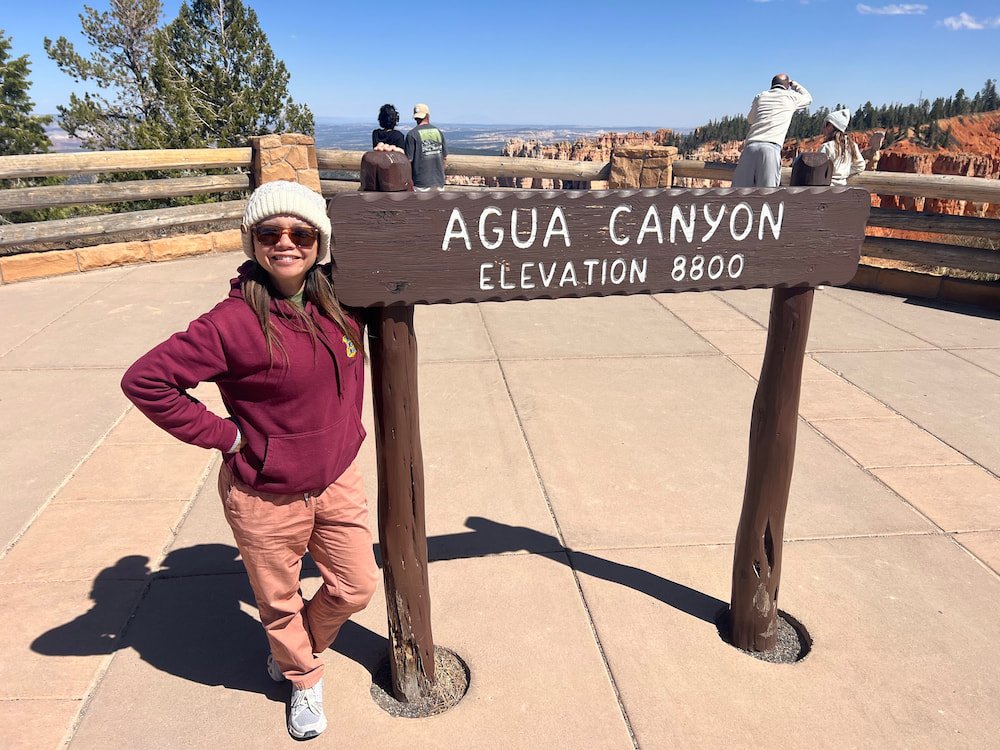
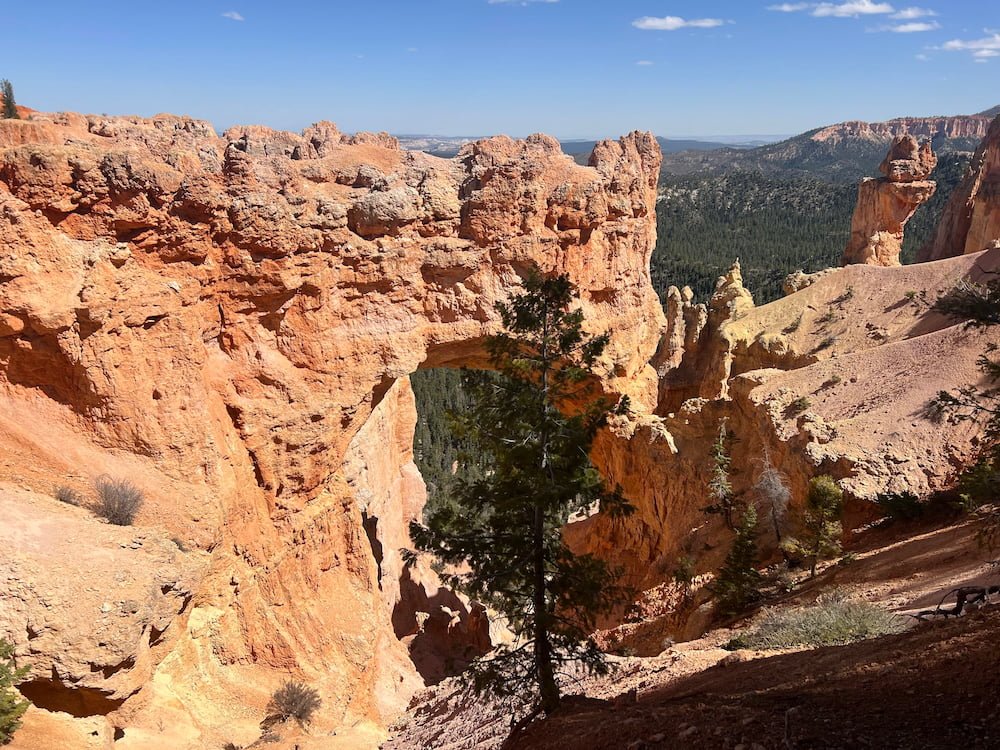
Exploding Potato Chips
Once we left the national park, we had noticed that there are a lot of other activities that are on offer to tourists, which we imagine would be very popular in the busier summer months. For example, there are evening rodeos, or other ways to access the park and its surroundings by going mountain biking (there are some great bike trails, which we would've done had one of the eBikes not had a finicky battery) flightseeing (doing a helicopter tour over Bryce Canyon), or skiing cross country on the nearby trails.
We had to get a few groceries so we did this at a nearby store, and couldn't help but notice and laugh at the packets of potato chips! Due to the high elevation, all of the packets had swelled like a balloon as they'd been packed on much lower ground. Opening a packet would probably be better with scissors rather than trying to do it by hand and risk having the packet explode!

Dispersed Camping and Uh-Oh, Water Pump!
That evening, we entered a dispersed campground, which our fellow Swiss travelers had recommended to us the previous day. There were plenty of spaces for people to have their own spots to park, enshrouded by trees, and in a peaceful spot for the evening! Even though there were quite a few folks who had already camped for the evening when we arrived, we were very lucky to get a generous-sized spot with plenty of space for us to sprawl out. It was still chilly and very windy though (with the occasional strong gust blowing dust into our eyes and all around us), but we were content to be indoors and still get to see the beautiful stars from within our RV enclosure.
After making and eating dinner, Lisette went to wash the dishes, only to switch on the water pump and find that there was no water coming out! We still had half a tank of water, so we definitely hadn't run out -- the switch simply wasn't activating the water pump. Based on an inspection (and looking up possible causes online), we guessed that there was some issue with the water pressure switch, and we'd simply have to troubleshoot the issue somehow the next day.
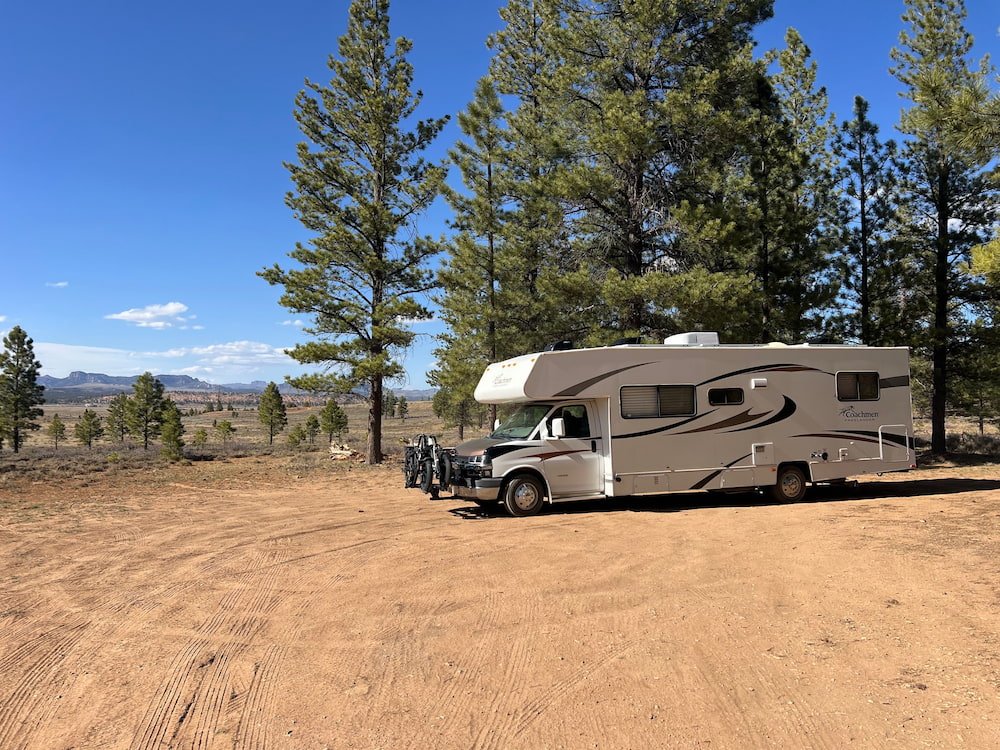
Peekaboo: I See Hoodoos!
The next morning, we figured that we wouldn't need our water pump to work immediately, as we could fill up our water bottles at the national park, use the toilets there, etc. So we drove straight into the park to go on our longer hike. Compared to the previous day, the temperatures were chillier, perhaps contributing to the fewer visitors and allowing us to park within Bryce Canyon. From here, it was a short trek to the shuttle bus stop.
We'd planned initially to alight at Sunset Point or Sunrise Point to tackle the Queen's/Navajo Combination Loop, one of the most popular hikes that would take us 4.6 kilometers (2.9 miles), and an estimated two hours or so. However, the shuttle bus stopped first at Bryce Point, which provided sweeping vistas from 2,529 meters (8,296 feet) elevation, and we promptly decided to get off here to check out the view and start our hike from here instead, as it would eventually join up to Sunset Point and Sunrise Point.
In hindsight we were really happy to have made this decision! Bryce Point perfectly set the scene for our hike, as we were suddenly confronted with literally thousands of hoodoos once we got to the vantage point, and saw how each turret-like formation contributed to a majestic mass of red and white rock formations below us.
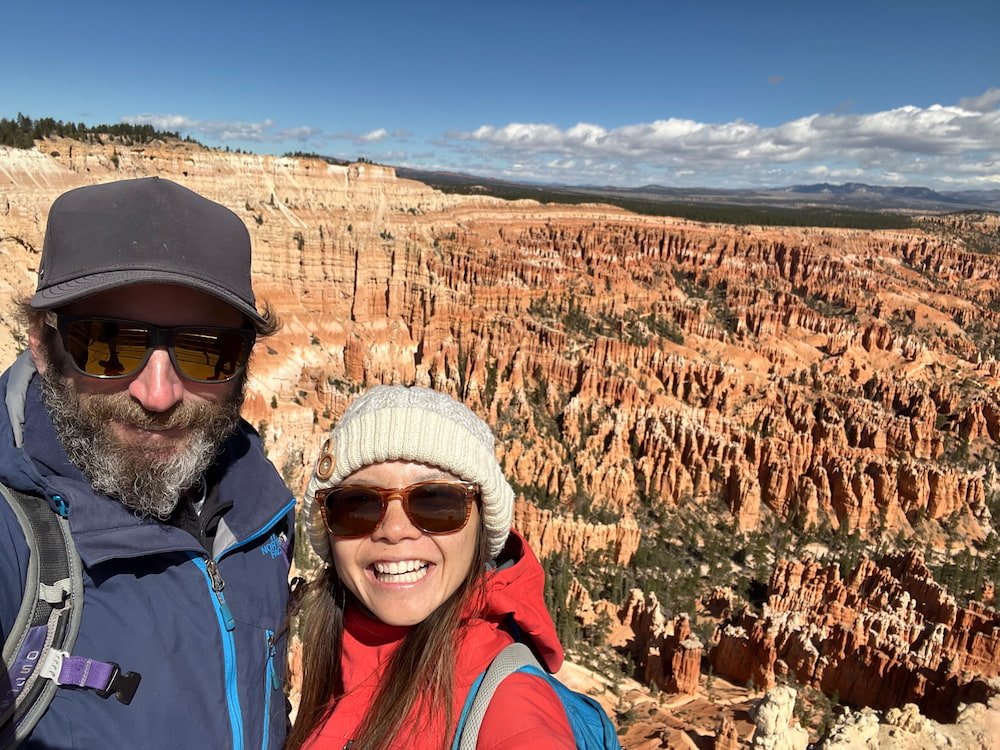

From Bryce Point, we started the hike on Peekaboo Loop Trail, which we audibly gasped at once we saw it from the top, with the winding trail opening up beneath us to even more hoodoos, which we would get to sidle up to as we walked along.
It was probably around this time, as we commenced our hike and saw what was ahead of us, that we both promptly decided that this was our favorite national park in terms of the absolutely stunning, one-of-a-kind views that this place showed off to us. We'd walk along and then turn a corner, where we'd be immediately amazed by the next hoodoos and views in front of us -- whether it was a towering rock, the edge of a path that opened up to a beautiful view below, or a natural arch we could walk through. Of course, this meant that we stopped (like many other people) to take a million photos along the way using our phone cameras. Our advice is to make sure to have your phone fully charged (or carry a spare portable battery), and put the phone on airplane mode, as it's easy to want to take heaps of pictures! We even heard someone pass us who made the comment of putting her phone on airplane mode to preserve the battery along her hike, so it's evidently a common thought!
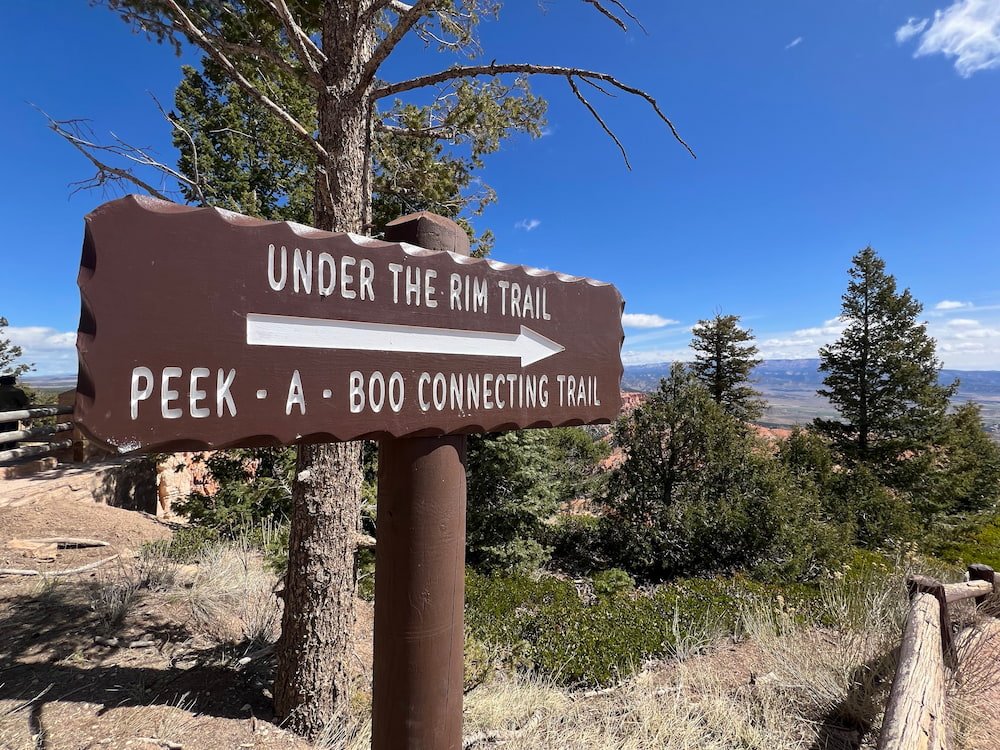

As we walked down, around, and up the trail, we noticed that there are both hiking and horseback trails that wind through the Park, both along the rim and among the hoodoos. The hiking and horseback trails are distinct from each other, so we didn't encounter anyone on horseback on the same path as us, but rather from a distance at one point during our hike.
The beginning of the hike was chilly, but it was sunny so we naturally became warmer as we continued along. We briefly chatted with a couple who had come from Melbourne and were traveling around the country for a couple of months, and were planning to do some of the popular cities like Las Vegas, San Francisco, and Los Angeles as they'd never been to the US before. We must admit that our accents can be quite strong -- in their case their looong vowels and "yea nah" responses were a dead giveaway from a mile away!
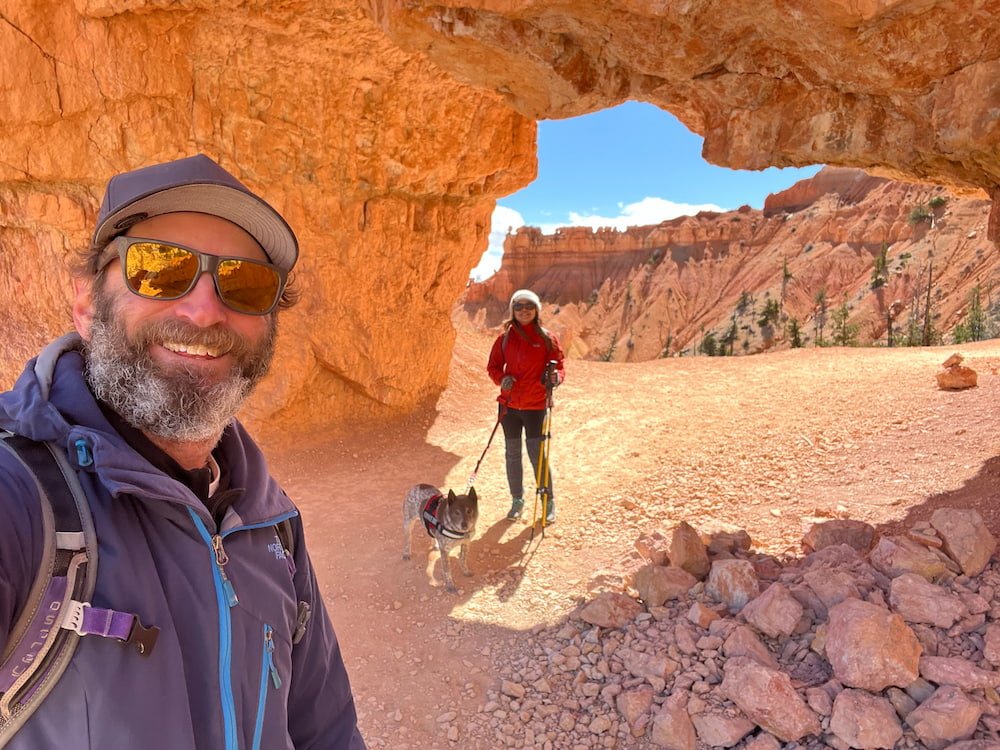

From the bottom of the Peekaboo Loop Trail, we were able to connect to the Navajo Loop Trail, which would also connect to the popular Queen's Garden Trail that we had initially intended to start from. Since we'd started at Peekaboo Loop Trail, we didn't encounter as many people here, but it got much busier as we got to Navajo Loop Trail and after that.
Of course, Sheila did see a couple of little squirrels, which she became extremely excited about, but otherwise she seemed to be just as amazed by the hike and all the different things to see and sniff at! We sometimes wonder what she makes of all her new adventures each day, as everyday is so different from the last, as opposed to her home life when she had a much more predictable routine -- from the times we'd wake up, to when and where she'd have her walks around the neighborhood.
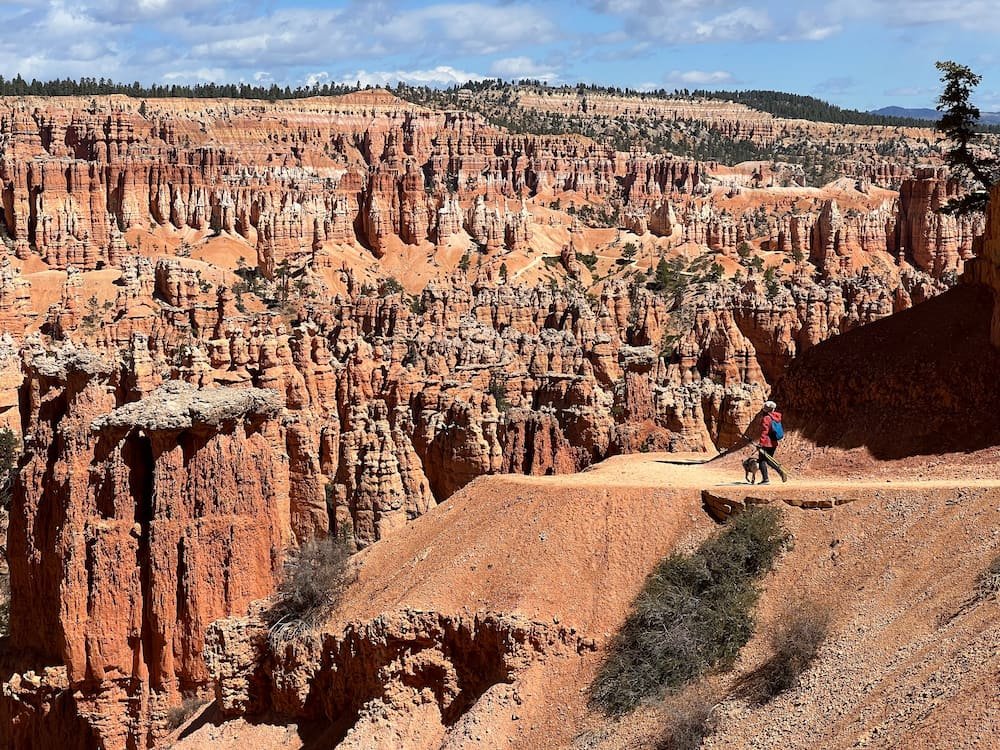

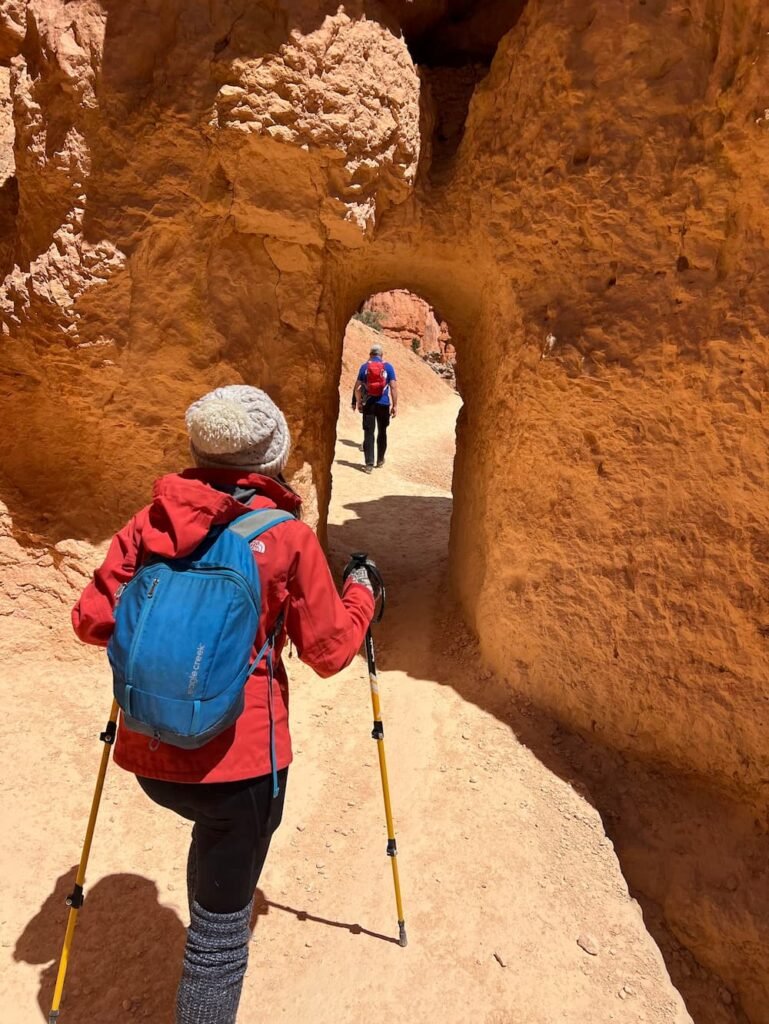
There was a brief part of our hike where we (and a couple of other folks) had to whip out the paper map to get our bearings, as several paths converged onto each other. The last part of our hike was heading back uphill to get to the top of Sunrise Point. It's a bit steeper because the trail doesn't wind around with the various switchbacks like we had at the beginning, but it was so wonderful to turn around at this point to look back and see how far we'd come (based on the tiny specks of people in the distance), and the extent that we'd walked down to get into the heart of Bryce Amphitheater, where the majority of the hiking trails are located.

We made it back to the top, where there were a ton of people congregated around the vista points. It started to feel icy cold again as we waited at the shuttle stop, sitting in the shade and having the chilly breeze hit us and our warm skin. We were able to make lunch in the RV with minimal dishes to leave in the sink (yep, still no water). We would have happily stayed another night in the same dispersed camping spot as the night prior to see Bryce Canyon for another half day and do a shorter hike, but alas, the universe decided that we should move on as we needed to stay at an RV park where we could plug into city water -- and the RV parks by Bryce Canyon seemed not only to be full already at this time of year, but also would be much more expensive compared to us finding a place an hour or so away, traveling north toward Salt Lake City.

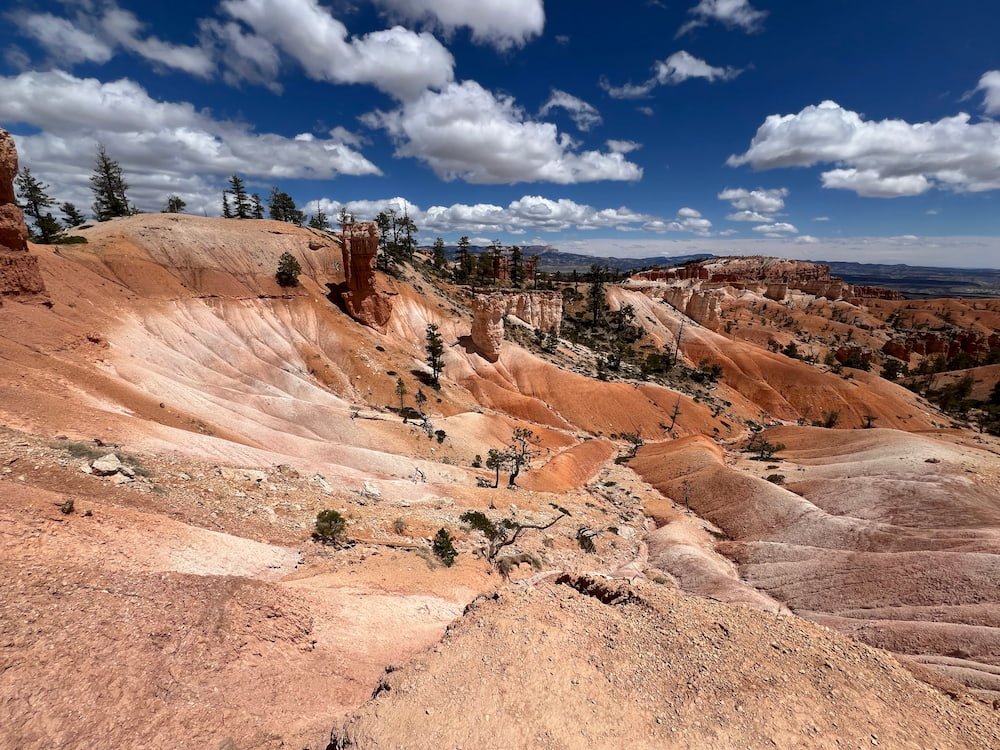
A Change of Scenery and Giant Soda Cans
So, goodbye Bryce Canyon National Park! We will be singing your praises as we left our footprints behind on the trail, and in return took such enchanting memories with us.
We weren't sure where we'd end up staying, but Lisette ended up finding a marker on Google Maps for a tourist attraction called the Giant Soda Cans, on our way north in a town called Salina. So we started our drive, and very quickly the scenery changed from hoodoos and red rocks to somewhere that wouldn't look out of place in Scotland! Brown rocks, fertile green hills, and grey skies greeted us, as well as the odd farmland complete with sheep, cows, horses, and little streams. We were amazed to see how varied the terrain could become so rapidly. Above us soared eagles and vultures, and the grey sky (like we'd expect in Scotland), opened up for it to start raining (with just a touch of sleet) on us.
Once we arrived in Salina it seemed that this little city of about 2,660 people was best known for being a pit stop, with numerous gas stations for truckers and other visitors to fill up as they continued on their long drives. But it was here that we stopped behind a gas station and a Carl's Jr. fast-food burger joint to briefly check out the Giant Soda Cans, which are simply tanks painted to resemble several popular soda brands. It's a very short stop to simply take some happy snaps.
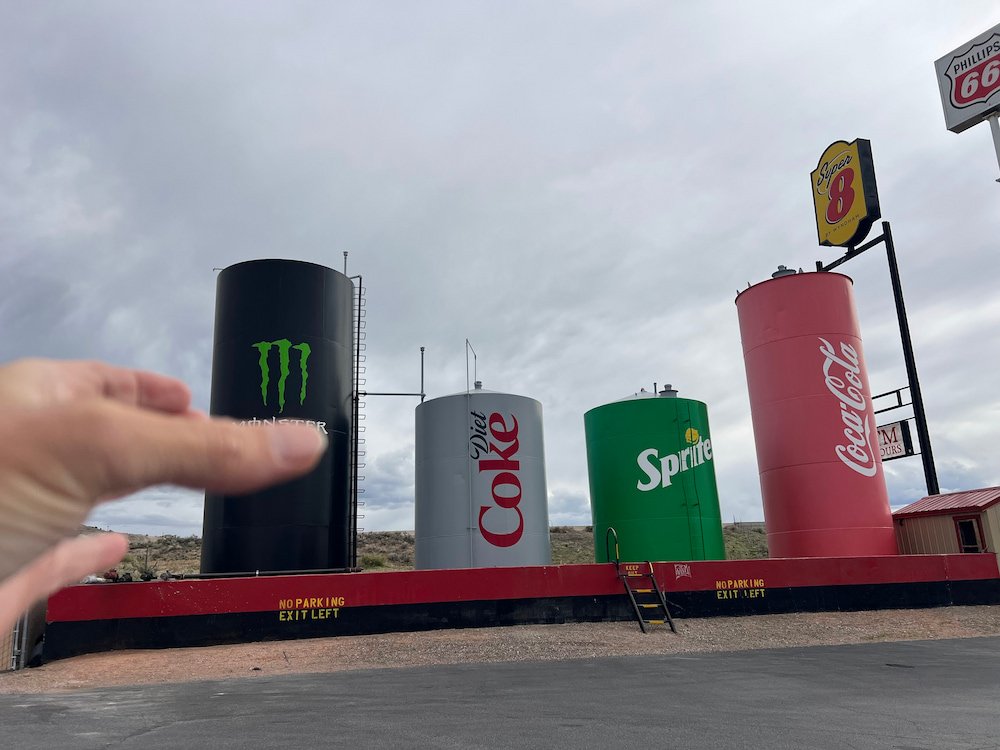
The Cleanest RV Park We've Been To So Far
Michael decided that rather than stop here, we'd continue to an RV park he found, called Rollin Home RV Park in the city of Nephi, south of Salt Lake City. As we got close to the RV Park, we could see incredible snowcapped mountains in the distance, which looked absolutely incredible and dramatic with the grey skies overhead. We arrived at the RV Park after hours, but as soon as we got there we were impressed. It is hands-down the nicest, cleanest and most well-maintained RV Park that we have been to! The RV Park is relatively new, opening in 2020, but it really feels like the management takes great care and pride with the upkeep of the park. The toilets and showers were spotless, and it was so wonderful to have a nice, hot shower that evening, and have ample space between us and the RVs parked next to us (there's a strip of grass separating us on either side). Ahhhhh! Time for us to unwind with the beautiful mountains in the background for the night, after quite a decent drive from Bryce Canyon National Park and another eventful day.
Quiz Answers
So, did you know what's the difference between 1) a National Park vs National Monument designation, and 2) a National Park vs State Park designation? Here's what we learned:
- National Parks are created by Congress to protect diverse resources, including national and historic features, for their scenic, inspirational, educational and recreational value. National Monuments are created by the President through the Antiquities Act, and preserve a specific, nationally significant resource, whether natural, historic, or cultural.
- Besides the difference in which governmental agency oversees them (ie the US Department of the Interior versus the state agency), national parks are typically larger, with a focus on conservation - ie preserving natural and cultural resources for future generations. State parks can focus more on utilization - and can range from small urban parks to large wilderness areas, with a wider variety of amenities and activities.
The more we know!
Route Map
